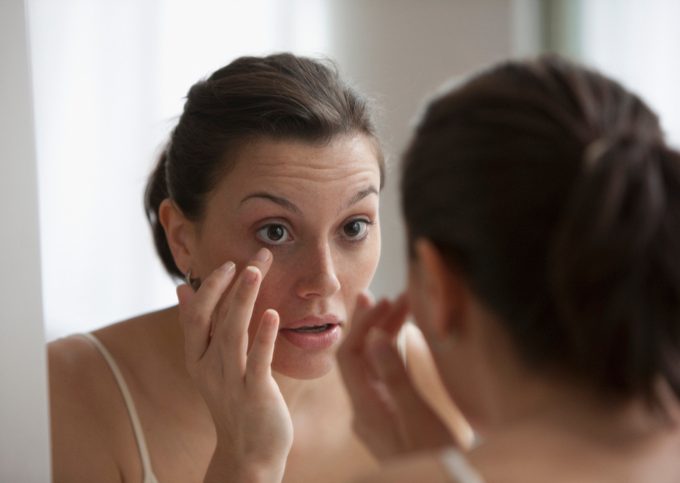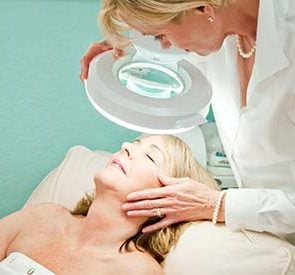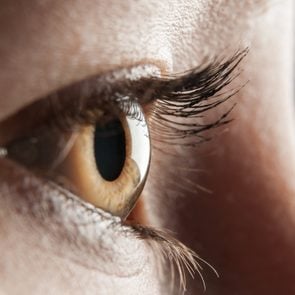What Is Ocular Rosacea? How Rosacea Can Cause Red Eyes
Updated: Jun. 30, 2021
If you have dry, red, burning eyes, you may be feeling the effects of ocular rosacea. Here's how to spot this condition, as well the treatments, diet, and lifestyle changes that help control it.
Allergies, or something else?
Dry, irritated, bloodshot eyes often mean seasonal allergies. But they could also be a sign of rosacea, a skin condition that affects 16 million Americans. Rosacea commonly appears as red cheeks that don’t go away, and can involve a sudden “flushed” feeling of warmth and redness to the face, as well as pimple-like bumps on the face.
But sometimes, rosacea can affect the eyes as well, even if you don’t have skin symptoms. This subtype is called ocular rosacea.
“While ocular rosacea can occur along with facial rosacea, this is not always the case,” says Alison Watson, MD, an ophthalmologist with a sub-specialty in oculofacial plastic and orbital surgery at Wills Eye Hospital in Philadelphia. “In fact, patients can have facial rosacea without ocular rosacea, or ocular rosacea can be present in isolation. When they are present together, one does not predictably occur before or after the other.”
According to the National Rosacea Society, about half of people with rosacea will have eye symptoms, and about 20 percent of rosacea patients have eye symptoms before facial symptoms.
If you’ve already been diagnosed with rosacea, you can be on the lookout for eye issues; but if you haven’t, the cause of your eye problems may be harder to spot.
Luckily, once you’re diagnosed, medical treatments and procedures can be very effective. In addition, “identifying and avoiding triggers, which may range from diet modification to stress reduction, can also provide great benefit to reducing flares and severity of the disease,” Dr. Watson says. (Here’s how one woman found rosacea treatments that worked for her.)
Let’s take a closer look at ocular rosacea.

What are the signs of ocular rosacea, and who gets it?
“Rosacea can affect the eyes and eyelids in various ways,” says Steven Zabin, MD, an ophthalmologist at Westmed Medical Group in Westchester, New York. “The skin around the eyes often becomes red with superficial blood vessels as well as pustules (pus-filled pimples). The eyes often show a chronic redness due to engorgement of the conjunctival blood vessels,” which are under the eyelid.
In addition, “the eyelids may become inflamed, and a history of styes or (benign cysts called) chalazia are common,” Dr. Zabin says.
This inflammation, called blepharitis, may make your eyelids irritated, itchy, and even crusty. Styes are caused by an infected eyelash root; chalazia result from clogged oil glands in the eyelid. You also may feel like something is in your eye. More severe cases can also cause visual disturbances, Dr. Zabin says.
“Although it is most common among middle-aged women, it can also affect men and on occasion, children,” he says. The reasons why rosacea mostly affects women isn’t known, although there may be a hormonal link.
What causes ocular rosacea?
The main way ocular rosacea impacts the eyes is through dilated blood vessels along the edge of the eyelid, and eyelid inflammation, says Dr. Watson. “Additional symptoms stem from this inflammation, which causes dysfunction of the eyelid oil glands and consequent eye irritation, redness, dryness, light sensitivity, and recurrent chalazia.”
As with rosacea in general, doctors don’t really know the underlying cause for these overactive blood vessels and inflammation in the eye. “Some feel there may be a genetic predisposition, or heightened environmental sensitivities, that make certain people vulnerable to developing ocular rosacea,” Dr. Watson says. “This results in abnormal behavior of the blood vessels of the skin and eyelids, resulting in skin redness and swelling.”
The presence of an increased number of skin mites called Demodex in rosacea patients, including on the eyelids, could also have something to do with the development of ocular rosacea.
Treatment for ocular rosacea
A dermatologist and an ophthalmologist may be part of your team, helping figure out the cause of your eye woes. Once you’ve been diagnosed, “there are various medical treatment options for ocular rosacea,” Dr. Zabin says. “Oral antibiotics such as tetracycline or doxycycline may be prescribed to treat exacerbations, and some people are maintained on a low dose indefinitely if active disease recurs. If the patient (prefers) to get off the medication, cyclosporin eye drops can be used for chronic ocular inflammation.”
Antibiotics are used not because there’s a bacterial infection, but because they have anti-inflammatory properties, Dr. Watson says. In addition, “topical anti-microbial agents can also be used, most commonly, topical metronidazole.”
This medication helps ward off the Demodex mites. “Additionally, lubricating eye drops are utilized to help manage the symptoms of ocular rosacea,” she says.
Treatment with special devices that use heat or light may also be an option. “Depending on disease severity, occasionally in-office procedures to help unclog the eyelid oil glands (LipiFlow, which uses heat) or intense pulsed light (IPL) therapy may be used,” Dr. Watson says. IPL therapy uses light at specific wavelengths to help shrink blood vessels and reduce inflammation.
What you can do at home
You can help your ocular rosacea at home by taking care of your eyes and the skin around them.
“Lifestyle changes are an important part of managing ocular rosacea,” Dr. Watson says. “Incorporating warm compresses and eyelid scrubs with massage into your daily routine can help optimize the function of the eyelid oil glands. This improves (eye) comfort, and reduces tear evaporation and consequent dry eye.” Check with your doctor about which products to use.
In addition to warm compresses, Dr. Zabin says good eyelid hygiene can help reduce eyelid inflammation. The National Rosacea Society suggests gentle cleansing with baby shampoo. “Over-the-counter moisturizers can also can help to treat dry eyes,” Dr. Zabin says.
Avoiding triggers
Rosacea can be made worse by exposure to environmental triggers such as alcohol, spicy foods, the sun, stress, and temperature shifts. Dr. Zabin points out some additional foods that may make ocular rosacea worse.
“It’s recommended that people with ocular rosacea avoid certain environmental or dietary triggers that may exacerbate the condition,” he says. “Foods that are strong dilators of blood vessels can increase the redness and the degree of inflammation of the eyes and lids.
Foods that contain cinnamaldehyde and capsaicin, such as peppers, spices like cayenne pepper, hot sauces, cinnamon, chocolate, citrus, and tomatoes, should be avoided.”
In addition, “recent studies have also shown a relationship between gastrointestinal disease and rosacea,” says Dr. Zabin. “Eating more probiotics—such as yogurt and fermented foods—as well as prebiotics such as legumes, whole grains, and vegetables may help with avoiding complications of ocular rosacea.”
And because the sun can also be a trigger, be sure to use sunscreen, sunglasses, and stay in the shade. “Avoiding sources of ultraviolet light, such as direct sunshine, as well as avoiding any direct heat source to the eyes and eyelids is highly recommended,” Dr. Zabin says.
What can happen if ocular rosacea is not treated?
If you don’t treat ocular rosacea, the condition can actually affect your vision. “If untreated, symptoms will persist,” notes Dr. Watson. “In more severe cases, it can result in injury to the cornea, the clear front part of the eye, with scarring and abnormal blood vessel growth.”
If you have any of the symptoms of ocular rosacea, contact your doctor to get treatment and prevent vision loss.



